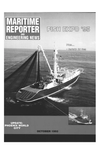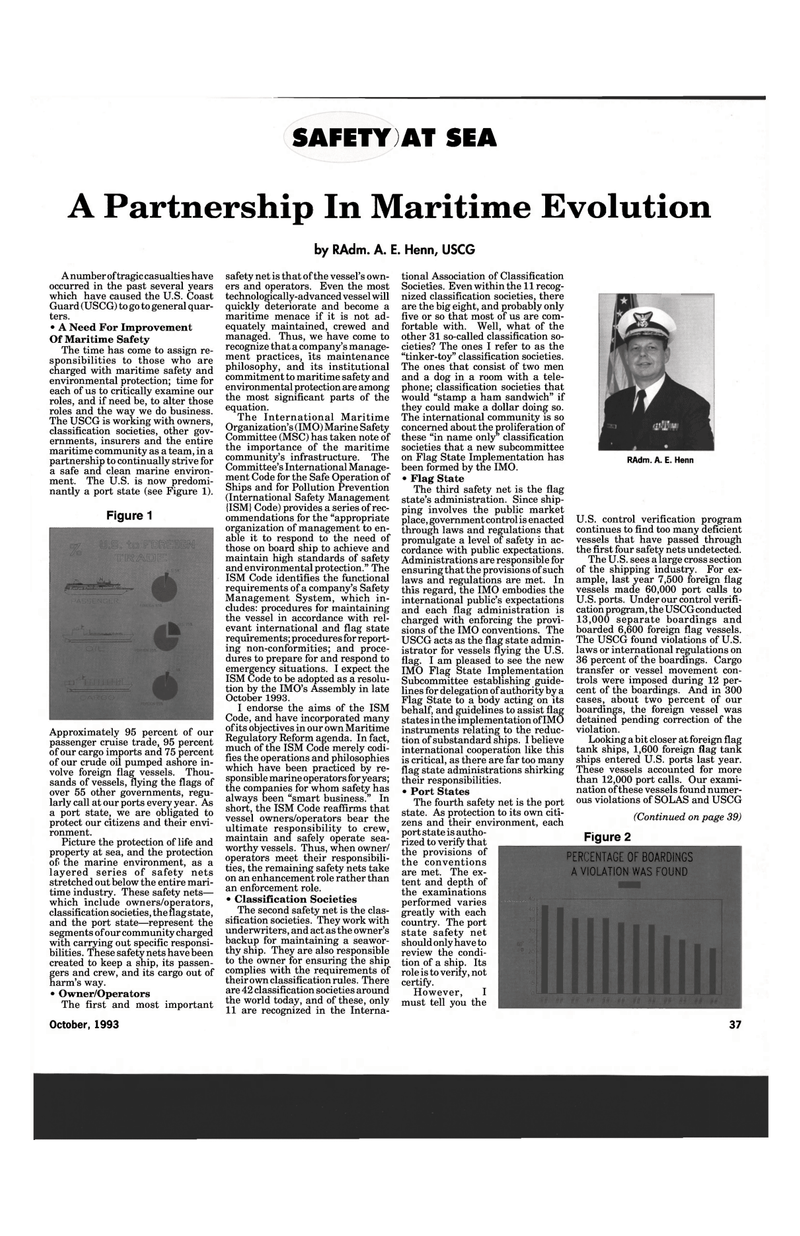
Page 35: of Maritime Reporter Magazine (October 1993)
Read this page in Pdf, Flash or Html5 edition of October 1993 Maritime Reporter Magazine
SAFETY AT SEA
A Partnership In Maritime Evolution by RAdm. A. E. Henn, USCG
A number of tragic casualties have occurred in the past several years which have caused the U.S. Coast
Guard (USCG) to go to general quar- ters. • A Need For Improvement
Of Maritime Safety
The time has come to assign re- sponsibilities to those who are charged with maritime safety and environmental protection; time for each of us to critically examine our roles, and if need be, to alter those roles and the way we do business.
The USCG is working with owners, classification societies, other gov- ernments, insurers and the entire maritime community as a team, in a partnership to continually strive for a safe and clean marine environ- ment. The U.S. is now predomi- nantly a port state (see Figure 1).
Figure 1
Approximately 95 percent of our passenger cruise trade, 95 percent of our cargo imports and 75 percent of our crude oil pumped ashore in- volve foreign flag vessels. Thou- sands of vessels, flying the flags of over 55 other governments, regu- larly call at our ports every year. As a port state, we are obligated to protect our citizens and their envi- ronment.
Picture the protection of life and property at sea, and the protection of the marine environment, as a layered series of safety nets stretched out below the entire mari- time industry. These safety nets— which include owners/operators, classification societies, the flag state, and the port state—represent the segments of our community charged with carrying out specific responsi- bilities. These safety nets have been created to keep a ship, its passen- gers and crew, and its cargo out of harm's way. • Owner/Operators
The first and most important
October, 1993 safety net is that of the vessel's own- ers and operators. Even the most technologically-advanced vessel will quickly deteriorate and become a maritime menace if it is not ad- equately maintained, crewed and managed. Thus, we have come to recognize that a company's manage- ment practices, its maintenance philosophy, and its institutional commitment to maritime safety and environmental protection are among the most significant parts of the equation.
The International Maritime
Organization's (IMO) Marine Safety
Committee (MSC) has taken note of the importance of the maritime community's infrastructure. The
Committee's International Manage- ment Code for the Safe Operation of
Ships and for Pollution Prevention (International Safety Management {ISM} Code) provides a series of rec- ommendations for the "appropriate organization of management to en- able it to respond to the need of those on board ship to achieve and maintain high standards of safety and environmental protection." The
ISM Code identifies the functional requirements of a company's Safety
Management System, which in- cludes: procedures for maintaining the vessel in accordance with rel- evant international and flag state requirements; procedures for report- ing non-conformities; and proce- dures to prepare for and respond to emergency situations. I expect the
ISM Code to be adopted as a resolu- tion by the IMO's Assembly in late
October 1993.
I endorse the aims of the ISM
Code, and have incorporated many of its objectives in our own Maritime
Regulatory Reform agenda. In fact, much of the ISM Code merely codi- fies the operations and philosophies which have been practiced by re- sponsible marine operators for years; the companies for whom safety has always been "smart business." In short, the ISM Code reaffirms that vessel owners/operators bear the ultimate responsibility to crew, maintain and safely operate sea- worthy vessels. Thus, when owner/ operators meet their responsibili- ties, the remaining safety nets take on an enhancement role rather than an enforcement role. • Classification Societies
The second safety net is the clas- sification societies. They work with underwriters, and act as the owner's backup for maintaining a seawor- thy ship. They are also responsible to the owner for ensuring the ship complies with the requirements of their own classification rules. There are 42 classification societies around the world today, and of these, only 11 are recognized in the Interna- tional Association of Classification
Societies. Even within the 11 recog- nized classification societies, there are the big eight, and probably only five or so that most of us are com- fortable with. Well, what of the other 31 so-called classification so- cieties? The ones I refer to as the "tinker-toy" classification societies.
The ones that consist of two men and a dog in a room with a tele- phone; classification societies that would "stamp a ham sandwich" if they could make a dollar doing so.
The international community is so concerned about the proliferation of these "in name only" classification societies that a new subcommittee on Flag State Implementation has been formed by the IMO. • Flag State
The third safety net is the flag state's administration. Since ship- ping involves the public market place, government control is enacted through laws and regulations that promulgate a level of safety in ac- cordance with public expectations.
Administrations are responsible for ensuring that the provisions of such laws and regulations are met. In this regard, the IMO embodies the international public's expectations and each flag administration is charged with enforcing the provi- sions of the IMO conventions. The
USCG acts as the flag state admin- istrator for vessels flying the U.S. flag. I am pleased to see the new
IMO Flag State Implementation
Subcommittee establishing guide- lines for delegation of authority by a
Flag State to a body acting on its behalf, and guidelines to assist flag states in the implementation of IMO instruments relating to the reduc- tion of substandard ships. I believe international cooperation like this is critical, as there are far too many flag state administrations shirking their responsibilities. • Port States
The fourth safety net is the port state. As protection to its own citi- zens and their environment, each port state is autho- rized to verify that the provisions of the conventions are met. The ex- tent and depth of the examinations performed varies greatly with each country. The port state safety net should only have to review the condi- tion of a ship. Its role is to verify, not certify.
However, I must tell you the
RAdm. A. E. Henn
U.S. control verification program continues to find too many deficient vessels that have passed through the first four safety nets undetected.
The U.S. sees a large cross section of the shipping industry. For ex- ample, last year 7,500 foreign flag vessels made 60,000 port calls to
U.S. ports. Under our control verifi- cation program, the USCG conducted 13,000 separate boardings and boarded 6,600 foreign flag vessels.
The USCG found violations of U.S. laws or international regulations on 36 percent of the boardings. Cargo transfer or vessel movement con- trols were imposed during 12 per- cent of the boardings. And in 300 cases, about two percent of our boardings, the foreign vessel was detained pending correction of the violation.
Looking a bit closer at foreign flag tank ships, 1,600 foreign flag tank ships entered U.S. ports last year.
These vessels accounted for more than 12,000 port calls. Our exami- nation of these vessels found numer- ous violations of SOLAS and USCG (Continued on page 39)
Figure 2
PERCENTAGE OE BOARDINGS
A VIOLATION WAS FOUND 37

 34
34

 36
36
